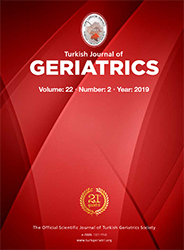2Esenyurt State Hospital, Department of Urology, Istanbul, Turkey
3Marmara University, Pendik Training and Research Hospital, Department of Urology, Istanbul, Turkey DOI : 10.31086/tjgeri.2019.93 Introduction: To evaluate the clinical efficacy and safety of botulinum neurotoxin A injection in geriatric patients with an overactive bladder.
Materials and Method: Data of 34 patients aged >65 years who received botulinum neurotoxin A injections (100 U) for overactive bladder at two different urology clinics from 2012 to 2018were retrospectively evaluated. Number of incontinence episodes, urinary frequency, nocturia occurrence, daily pad usage, maximum flow rate, post-void residual urine volume, treatment benefit scale and quality of life scores were evaluated for all patients at pretreatment and then at 3 and 6 months post treatment.
Results: Comparison of the pre-treatment and the 3- and 6-month post-treatment data revealedno significant changes in maximum flow rate values (p=0.504 and 0.458, respectively); however, a statistically significant decrease was recorded in the urinary frequency, nocturia occurrence, daily pad usage and number of incontinence episodes (p=0.0001). The post-void residual urine volume significantly increased at 3 and 6 months post treatment (p=0.0001). Significant improvements were detected in the quality of life score at 3-months post treatment (p=0.0001).
Conclusion: Botulinum neurotoxin A injection is an efficacious and safe option for treating geriatric patients and improving their symptoms of overactive bladder and quality of life.
Keywords : Urinary Bladder, Overactive; Botulinum Toxin, Type A; Quality of life; Aged; Geriatrics
